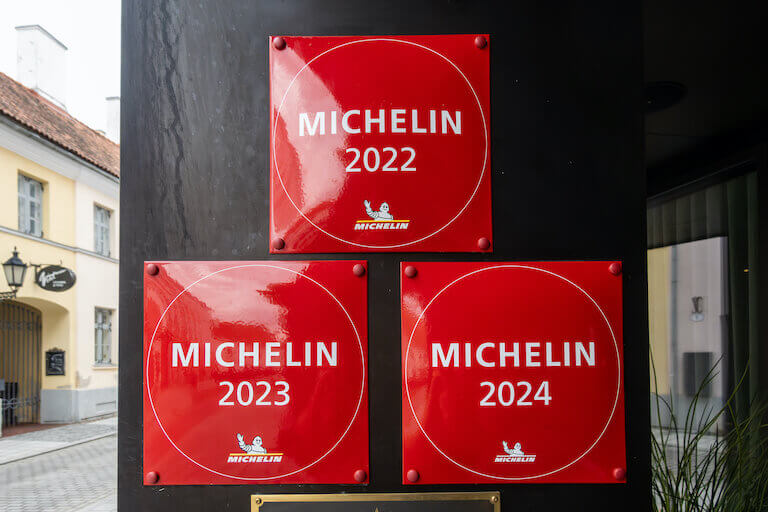Listen to This Article:
Have you ever wondered how restaurants get Michelin Stars? Or how the Michelin Star rating system came to be?
The iconic rating, which is awarded to restaurants that meet exceptionally high standards of cooking, has an origin story with very little relation to cuisine.
Here at Auguste Escoffier School of Culinary Arts, we thought you should know the whole story. After all, some of the cooks we’re training may aspire to join the ranks of restaurants recommended in the famous Michelin Guide.
The Unexpected Origins of the Michelin Guide
Interestingly, the invention of the Michelin Star rating coincides with the invention of the automobile. Michelin Tire founders and French industrialist brothers Andre and Edouard Michelin compiled the first Michelin Guide in 1900 with the aim of creating a demand for automobiles—and therefore, a need for more Michelin tires.

The Michelin Star rating coincided with the invention of the automobile.
The French guide was handed out for free and included maps, plus instructions on how to repair and change tires. To encourage drivers to use their cars and explore a little more, the guide also included a list of restaurants, hotels, mechanics, and gas stations along popular routes in France.
Michelin Guide expanded rapidly and became available throughout Europe and Northern Africa within a decade.
The Evolution of the Michelin Star Rating System
The outbreak of World War I in 1914 temporarily halted production of the guide, but by 1920 it was back on track and about to enter an important new phase. According to the Michelin Guide website, Andre Michelin showed up at a tire shop one day to find one of the guides being used to prop up a workbench.
“Based on the principle that ‘man only truly respects what he pays for,’ a brand new MICHELIN Guide was launched in 1920 and sold for seven francs,” so the story goes.
The Michelin brothers ramped up the guide’s quality, eliminated advertising, added a list of hotels in Paris, and categorized the list of restaurants. They also recruited mystery diners to visit and review restaurants anonymously.
The guide began awarding Michelin Star ratings in 1926. The restaurants, all of which were in France, were awarded a single star if they were deemed a “fine dining establishment.” In 1931, the rating system expanded to the three-star rating that continues today.
Unlike most star rating systems, one star is not considered a demerit. Any number of Michelin Stars granted to a restaurant signals a huge honor and a rare accomplishment.
Michelin Guide Star Rating Descriptions
- One star: A very good restaurant in its category.
- Two stars: Excellent cooking, worth a detour.
- Three stars: Exceptional cuisine, worth a special journey.
According to Military.com, “In the 1939 Michelin Guide, there were hundreds of heavily detailed and up-to-date maps of France itself and French cities, like Cherbourg, Caen, and St. Lo, all of which would become critical crossroads for the D-Day invasion.”
The guide started up again in 1945. In 1955, Michelin came up with a rating system that acknowledged restaurants serving high-quality fare at moderate prices, called the Bib Gourmand. This system highlights dining opportunities that are more reflective of economic standards. Because the ratings are customized by region and country based on the cost of living, the Bib Gourmand gives diners a chance to eat well without breaking the bank.
The Michelin Guide in the 21st Century
The Michelin Star rating didn’t take hold in the United States until 2005, and it began by concentrating solely on fine dining in New York City. Today, the Michelin Guide reviews restaurants in select U.S. cities, including Chicago, New York City, Los Angeles, Las Vegas, and San Francisco. If one of your goals as an aspiring chef is to work at a Michelin Star restaurant, you may want to focus on these cities after graduation. Choosing to attend culinary school in Chicago, culinary school in New York, or another major city can offer you a front-row seat to the most innovative dining experiences.
The Michelin guide now covers 37 countries across Europe, Asia, North America, and South America. There’s also a related ranking — the Michelin Green Star — which is awarded to the best, most sustainable restaurants around the world.
Top Five Countries With the Most Michelin Star Restaurants (2024)
- France: 636
- Japan: 387
- Italy: 381
- Germany: 330
- Spain: 267
(source)
How Does a Restaurant Get a Michelin Star?
To determine who receives the annual award, the Michelin Guide team will first select a number of restaurants in specific locations to be inspected by anonymous reviewers, called inspectors. The inspectors visit multiple times in different seasons and at different times, i.e. making sure to eat lunch and dinner and to visit on weekends and during the week.
Inspectors write a comprehensive report about the total culinary experience, including the quality and presentation of the dishes, among other rating criteria outlined below. The group of Michelin inspectors will then meet to analyze the reports and discuss in-depth which restaurants are worthy of a Michelin Star (or two or three).
Who Are the Michelin Inspectors?
Michelin inspectors are full-time employees of Michelin, and it’s important that they remain anonymous. The Michelin Guide itself doesn’t say much about who the inspectors are, other than “Our inspectors are experts in food, dining, and hotel sectors with many years of experience working in the hospitality industry.”
However, some news outlets have managed interviews and glimpses into their lives. One article said the inspectors are “hotel professionals with at least 10 years of work experience in that particular field,” adding that “Inspectors are also known to have culinary degrees, have worked in either the front or back of the house and may even be a trusted sommelier.”
The inspectors may travel three weeks out of every month and dine out up to 10 times a week. They will return to a restaurant at different times, and the top restaurants will typically see visits from multiple inspectors over the course of a year.
Elements of the restaurant, such as ambiance, decor, and quality of service are supposedly not considered in the report, but many think that the total experience may subconsciously woo the reviewers.
Chef Curtis Duffy, a friend of Auguste Escoffier School of Culinary Arts, partnered with Michael Muser to build the restaurant Grace in Chicago, which was honored with three Michelin Stars four years in a row, from 2015 to 2018. In July 2020, Duffy opened a new restaurant called Ever, which has earned two Michelin Stars.
Michelin Inspector’s 5 Restaurant Rating Criteria
- Quality of products
- Mastery of flavor and cooking techniques
- The personality of the chef represented in the dining experience
- Value for money
- Consistency between inspectors’ visits
How Important Are Michelin Stars?
No doubt, restaurants that receive a Michelin Star rating gain prestige and usually get an increase in exposure and business. However, because of the extremely high expectations in the rating system, there’s been a growing trend to reject Michelin Star ratings around the world—some restaurateurs even demanding that their star rating be removed. They feel that the expectations of the star system are unreasonable and restrict a chef’s creativity in the kitchen.
Still, in today’s culinary industry there’s a reverence for the iconic Michelin Star rating system. Some restaurateurs go so far as to say it’s the only rating that matters, deeming it authentic because Michelin inspectors are among the few who remain completely anonymous when reviewing a restaurant.
Although some restaurant owners and employees claim to have figured out how to identify an inspector, in theory the casual diner will have the same experience as the inspector. And if a restaurant is attentive enough to figure out the signals a Michelin Star inspector gives away, then that’s a restaurant that pays very close attention to its craft, and is probably worth a visit!
*Information may not reflect every student’s experience. Results and outcomes may be based on several factors, such as geographical region or previous experience.
Take the First Step to Excellence
Although chefs don’t earn Michelin Stars, the head chef at a restaurant is often given credit for the restaurant’s success. Therefore, many young chefs dream of one day leading a restaurant to Michelin Star status.
One way to begin this journey can be by attending culinary school. Escoffier’s culinary arts programs introduce students to a wide range of topics including food safety, world cuisines, flavor development, and entrepreneurship. But students don’t just learn about these topics in the classroom—they practice them in the kitchen and eventually test them out during an industry externship.
If you want to find out what culinary school could look like for you, contact us today to explore your options.
TO FIND OUT MORE ABOUT CULINARY EXCELLENCE, CHECK OUT THESE ARTICLES:
- Which Chefs Have Earned the Most Michelin Stars?
- How to Become a Chef: The Complete Guide
- Michelin Green Star: Most Sustainable Restaurants in the U.S.
This article was originally published on February 10, 2016, and has since been updated.



